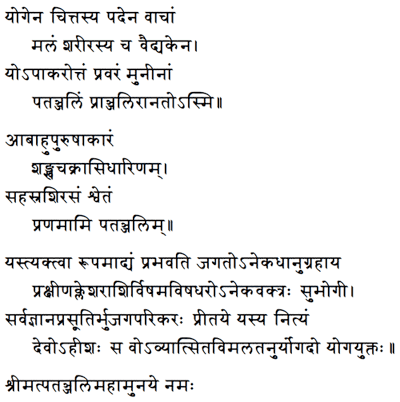
English Transliteration
yogena cittasya padena vacam
malam sarirasya ca vaidyakena
yopakarottam pravaram muninam
patanjalim pranjalir anato’smi
abahu purusakaram
sankha carkrasi dharinam
sahasra sirasam svetam
pranamami patanjalim
Listen to B.K.S. Iyengar chanting the Invocation to Patanjali:
Commentary and Translation of the Invocation to Patanjali
by Smt. Geeta S. Iyengar
The two slokas (verses) that we chant to invoke Lord Patanjali begin the Bhojavritti, Bhoj’s commentary on the Yoga Sutras. It says, first of all, that Lord Patanjali is considered to be the incarnation of Adhishesha, the cobra, which is the seat for the Lord Vishnu, the very creator of this world. It is said he took birth three different times, giving three different sciences for people to improve themselves. The first is yoga.
yogena cittasya padena vacam
To purify the mind (citta), purify the consciousness, Patanjali gave the science of yoga (yogena) to us. To purify our use of words (pada) and speech (vacca), he gave a commentary on grammar to us, so that our use of words and way of speaking is clarified, distinct and pure.
malam sarirasya ca vaidyakena
To remove the impurities (malam) of the body (sarira), he gave us the science of medicine (vaidyakena).
yopakarottam pravaram muninam
Let me go near the one who has given these things to us.
patanjalim pranjalir anato’smi
Let me bow down my head with my folded hands to Lord Patanjali. Then after knowing the work of this Lord, the second stanza says what Lord Patanjali looks like. To do any meditation first the form has to be in front of the eyes.
abahu purusakaram
From the hand up to the head he has the shape (karam) of a human (purusa).
sankha carkrasi dharinam
In his hand he is holding the conch (sankha) and disc (cakra)
sahasra sirasam svetam
On top of his head (sirasam) he has got a thousand (sahasra) hoods of the cobra, because he is the incarnation of Adishesha, the greatest cobra. Svetam means white.
pranamami patanjalim
I bow down to Patanjali.
We chant so that at the very beginning that feeling of sanctification comes from inside, with the feeling of surrendering oneself, because nothing can be learned in this world unless you have the humility to learn. So the moment you think of the Lord at the beginning of doing a practice, you know that you are very small in front of that greatest soul. Once that is understood then the other problems which always arise while practicing, mainly concerned with the ego, will be affected. You know that you are “coming down” to learn something. And you can’t learn anything unless you come down; if you think you are on the top and you know everything, then you are not a learner at all. In that sense, the chanting helps.